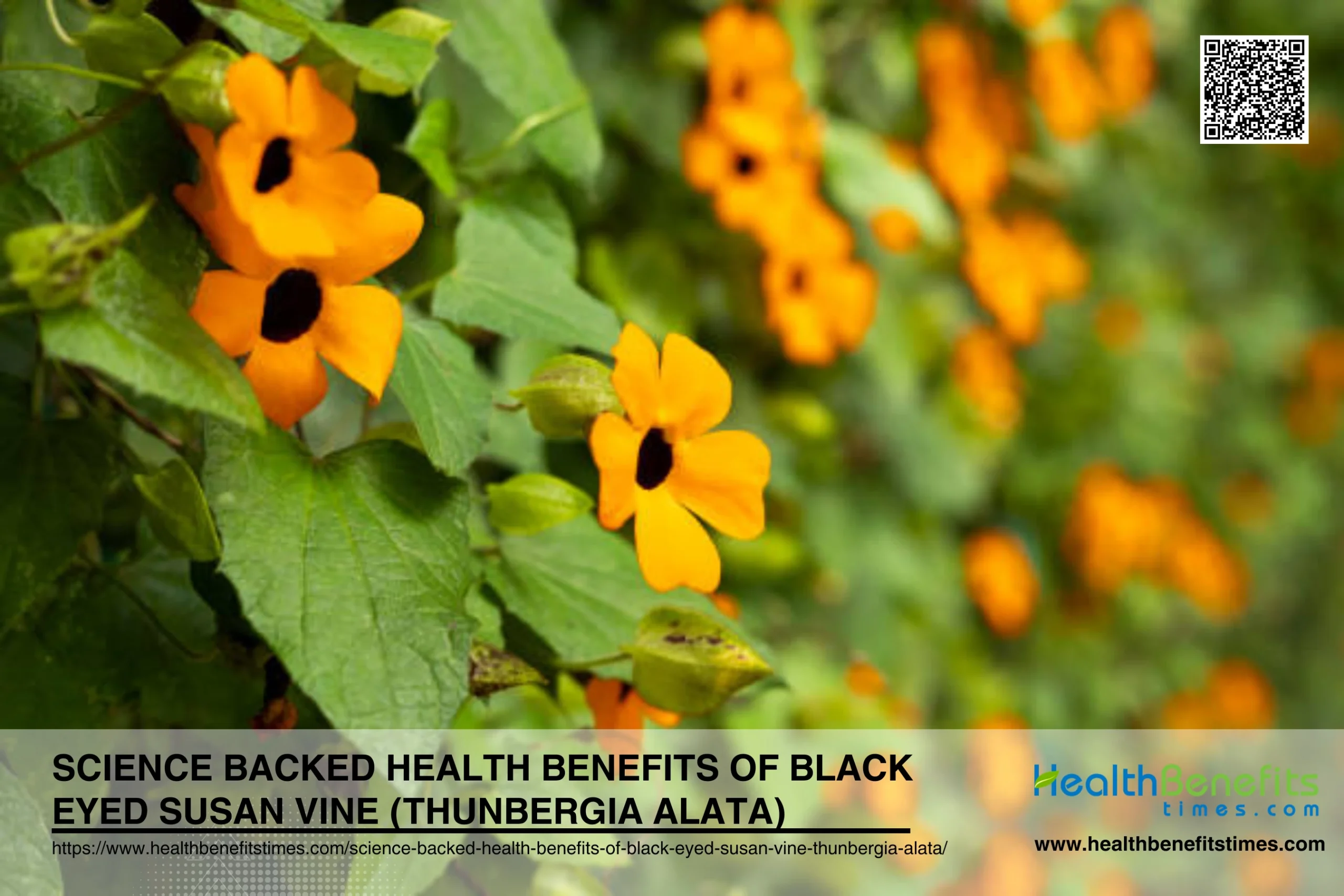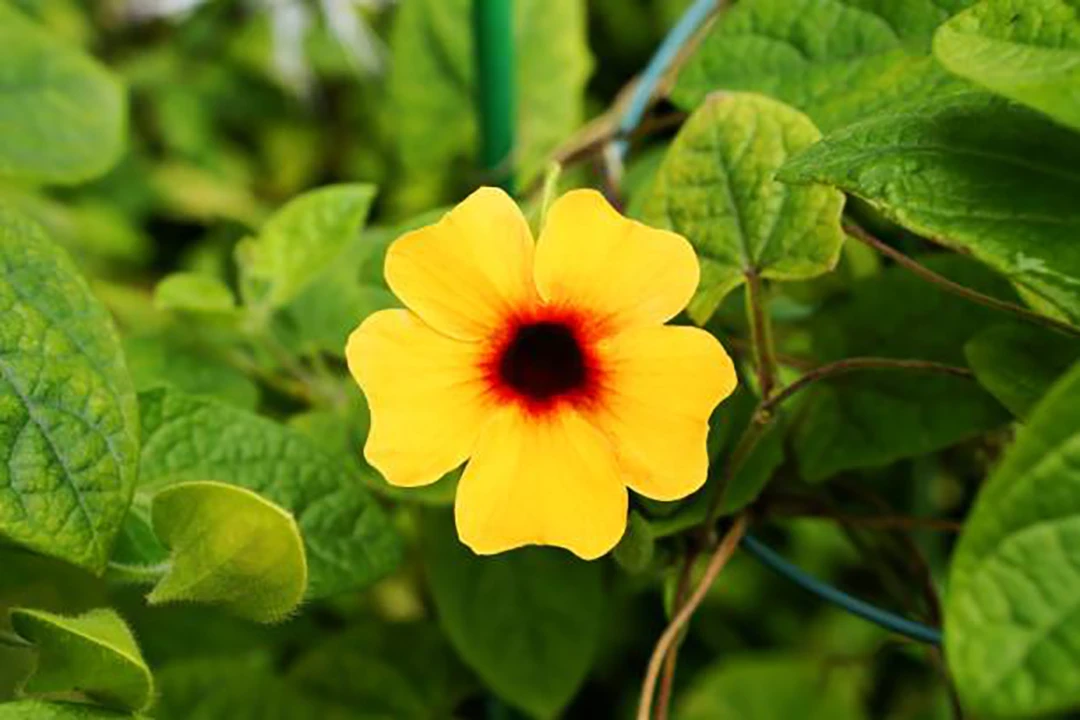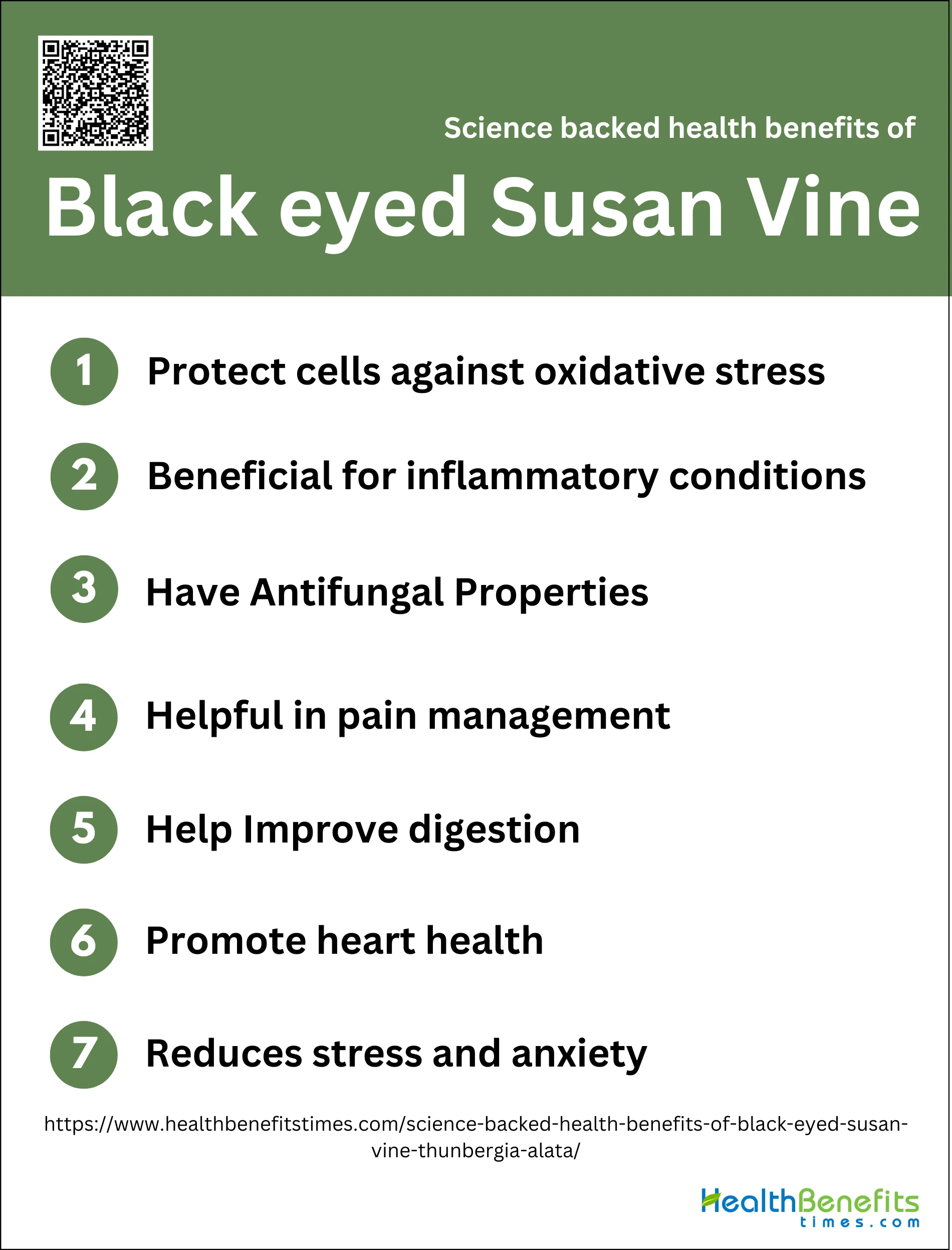- Black-eyed Susan Vine is an ornamental plant with medicinal, nutritional, and antioxidant properties.
- Blackeyed Susan Vine has Medicinal, antioxidant, anti-inflammatory, and antifungal properties.
- Blackeyed Susan Vine has potential for pain management, digestion, heart health, stress, and anxiety reduction.
- Bright, pollinator-attracting vine is easy care, perennial in warm zones, annual elsewhere.
- Dietary supplements may cause side effects, allergic reactions, and medication interactions.
 The science-backed health benefits of Blackeyed Susan Vine (Thunbergia alata) are captivating both researchers and traditional medicine practitioners alike. Native to East Africa and now flourishing in various parts of the world, this vibrant vine is more than just a garden ornament. Its rich phytochemical profile, including compounds like caffeoylmalic acid and iridoid glucosides, underpins its broad spectrum of medicinal properties. Traditionally, Thunbergia alata has been utilized to treat ailments such as fever, malaria, and skin infections. Modern scientific studies have confirmed its anti-inflammatory, antimicrobial, and antioxidant effects, highlighting its potential in addressing inflammatory diseases and skin conditions. This article delves into the diverse health benefits of Blackeyed Susan Vine, supported by both traditional uses and contemporary research findings.
The science-backed health benefits of Blackeyed Susan Vine (Thunbergia alata) are captivating both researchers and traditional medicine practitioners alike. Native to East Africa and now flourishing in various parts of the world, this vibrant vine is more than just a garden ornament. Its rich phytochemical profile, including compounds like caffeoylmalic acid and iridoid glucosides, underpins its broad spectrum of medicinal properties. Traditionally, Thunbergia alata has been utilized to treat ailments such as fever, malaria, and skin infections. Modern scientific studies have confirmed its anti-inflammatory, antimicrobial, and antioxidant effects, highlighting its potential in addressing inflammatory diseases and skin conditions. This article delves into the diverse health benefits of Blackeyed Susan Vine, supported by both traditional uses and contemporary research findings.
What is Black eyed Susan Vine ?
The Black-eyed Susan Vine is a flowering plant native to East Africa, widely recognized for its ornamental value and distinctive black-centered flowers. It thrives in tropical regions around the world and is considered invasive in some areas, such as Colombia. This plant has garnered attention not only for its aesthetic appeal but also for its potential medicinal properties. Local communities have traditionally used T. alata to treat various ailments, including malaria. Recent studies have explored its chemical composition, revealing the presence of saponins, terpenes, and flavonoids, with rutin and chlorogenic acid being the main components of its stem and leaf extracts. These extracts have demonstrated moderate antifungal activity against Candida strains, indicating promising therapeutic potential. Additionally, the seed oil of T. alata is notable for its high content of the unusual fatty acid A6-hexadecenoic acid, which constitutes more than 80% of the seed oil, suggesting unique biochemical pathways in its endosperm.
Nutritional Profile
The Blackeyed Susan Vine boasts a diverse nutritional profile that contributes to its potential health benefits. While specific data on T. alata is limited, studies on related Thunbergia species provide insight into its nutritional composition. For instance, Thunbergia fragrans seeds contain a significant protein content of 38.64%. The vine’s leaves and stems are likely sources of various phytochemicals, including saponins, terpenes, and flavonoids, as identified in ethanolic extracts. These compounds not only contribute to the plant’s nutritional value but also play crucial roles in its medicinal properties.
Overview of vitamins and minerals
Blackeyed Susan Vine and related Thunbergia species contain a range of essential vitamins and minerals. While precise data for T. alata is scarce, studies on other Thunbergia species reveal the presence of important minerals. For example, Thunbergia fragrans seeds are rich in phosphorus (1.233%), potassium (1.287%), magnesium (0.480%), and calcium (0.133%). Additionally, some Thunbergia species have been found to contain moderate amounts of iron. Vitamin C is also present in varying concentrations across different Thunbergia species, with T. grandiflora blue exhibiting the highest content (2.65±0.67) among studied varieties. These nutrients contribute to the overall health benefits associated with the plant.
Antioxidants present in the vine
Blackeyed Susan Vine is a rich source of antioxidants, which contribute significantly to its health-promoting properties. The plant contains various phenolic compounds, including caffeoylmalic acid, feruloylmalic acid, and p-coumaroylmalic acid. These compounds are known for their potent antioxidant activities. Additionally, T. alata extracts have been found to contain flavonoids, which are powerful antioxidants capable of neutralizing harmful free radicals in the body. The presence of these antioxidants not only supports the plant’s traditional use in treating inflammatory conditions but also suggests potential applications in managing oxidative stress-related disorders. Furthermore, the antioxidant properties of T. alata extracts have been demonstrated in various studies, highlighting their potential in protecting cells from oxidative damage.
Science backed health benefits of Black eyed Susan Vine
Discover the hidden potential of the vibrant Blackeyed Susan Vine, a plant that’s more than just a pretty face in your garden. This East African native, known for its striking yellow or orange flowers with dark centers, has been quietly making waves in the scientific community. Recent studies have unveiled a treasure trove of health benefits lurking within its leaves, stems, and blossoms. From potent anti-inflammatory properties to promising antimicrobial effects, Thunbergia alata is proving to be a powerhouse of natural remedies. In this article, we’ll explore the science-backed health benefits of this ornamental vine, shedding light on why it deserves a spot not just in your garden, but potentially in your natural health toolkit as well.
1. Protect cells against oxidative stress
Blackeyed Susan Vine is known for its potent antioxidant properties, which play a crucial role in protecting cells against oxidative stress. The plant contains a variety of phenolic compounds, such as caffeoylmalic acid, feruloylmalic acid, and p-coumaroylmalic acid, which are well-documented for their strong antioxidant activities. These compounds help neutralize free radicals, thereby preventing cellular damage and reducing the risk of chronic diseases associated with oxidative stress. Additionally, the presence of flavonoids in T. alata further enhances its ability to combat oxidative stress, as these bioactive molecules are effective in scavenging reactive oxygen species (ROS) and protecting cellular components from oxidative damage. The combined action of these antioxidants not only supports the plant’s traditional medicinal uses but also underscores its potential in modern therapeutic applications aimed at mitigating oxidative stress-related conditions.
What Research Says?
- Thunbergia laurifolia leaf extract boosts the work of antioxidant enzymes like catalase (CAT) and glutathione peroxidase (GPx). It also lowers malondialdehyde (MDA) levels. This helps protect cells from the stress caused by cadmium.
- Sargassum thunbergii, a different kind, greatly lowers ROS inside cells. It also boosts enzymes that fight oxidation, like superoxide dismutase (SOD-1) and glutathione reductase. This points to a powerful antioxidative process.
- Thunbergia alata seeds have a lot of rare fatty acids, like A6-hexadecenoic acid. Experts think special enzymes called desaturases make these acids. These fatty acids might help the plant fight off damage from oxidation.
2. Beneficial for inflammatory conditions

Blackeyed Susan Vine has demonstrated significant potential in managing inflammatory conditions, supported by both traditional uses and scientific research. Traditionally, the plant has been used in East Africa to treat various inflammatory ailments, including fever, cough, and backache, through oral administration of leaf and stem infusions. MTA inhibits the production of key pro-inflammatory cytokines such as interleukin-6 (IL-6) and interleukin-1β (IL-1β) in lipopolysaccharide (LPS)-stimulated macrophages, which are crucial mediators in inflammatory responses. This inhibition is achieved by reducing the activity of extracellular signal-regulated kinase (ERK) and signal transducer and activator of transcription 3 (STAT3), thereby preventing excessive inflammatory responses without affecting other pathways like nuclear factor-κB (NF-κB).
What Research Says?
- Thunbergia laurifolia has shown strong anti-inflammatory effects in studies. It could help lessen inflammation and its symptoms.
- The Thunbergia plants can fight swelling because they can block important swelling-causing substances like COX-2, PGE2, and different cytokines.
- Thunbergia plants also have antioxidant qualities. These can help lower inflammation by cutting down on oxidative stress.
- Other plants, like Vitis thunbergii, also fight swelling. This suggests they might have the same helpful parts as Thunbergia species.
3. Have Antifungal Properties
Blackeyed Susan Vine exhibits promising antifungal properties, making it a valuable plant in the fight against fungal infections. The ethanolic extracts of T. alata leaves and stems contain bioactive compounds such as saponins, terpenes, and flavonoids, which contribute to its antifungal activity. Specifically, these extracts have demonstrated moderate antimycotic effects against Candida strains, including Candida albicans and Candida auris, with minimum inhibitory concentration (MIC) values ranging from 5.00 mg/mL to 1.25 mg/mL. The presence of major compounds like rutin and chlorogenic acid further enhances the plant’s efficacy in inhibiting fungal growth.
What Research Says?
- Studies on plants from Tanzania, like Thunbergia alata, show that some plants can fight fungi like different Candida types and Cryptococcus neoformans. But, Thunbergia alata wasn’t marked as one of the strongest antifungal plants in this research.
- Thunbergia alata has a special enzyme called Δ6-16:0-acyl carrier protein desaturase. Scientists have studied its structure and found that it works in a very specific way. This enzyme is important for making rare fatty acids, which help shape the plant’s chemical makeup.
- Studies on Rudbeckia hirta, a similar plant, have found it can fight fungus and Gram-positive bacteria. This hints that plants in the same family might have the same abilities to battle fungus.
4. Helpful in pain management

While traditional uses of Blackeyed Susan Vine suggest potential applications in pain management, scientific evidence specifically supporting this claim is limited. Historically, the plant has been used in East African traditional medicine to treat various ailments, including back and joint pains. This traditional use hints at possible analgesic properties. The anti-inflammatory effects of T. alata, particularly its ability to inhibit pro-inflammatory cytokines like interleukin-6 (IL-6) and interleukin-1β (IL-1β), may contribute to pain relief in inflammatory conditions. However, it’s important to note that while these traditional uses and anti-inflammatory properties are promising, more rigorous scientific studies are needed to conclusively establish T. alata’s efficacy in pain management. As with any herbal remedy, it’s crucial to consult with a healthcare professional before using T. alata for pain relief, especially considering its potential invasive nature in certain climates.
What Research says?
- Thunbergia alata is often used for back and joint pains. It might have pain-killing properties. This plant has different active parts, like alkaloids and fatty acids. These may help ease pain.
5. Help Improve digestion
While there is limited scientific evidence specifically linking Blackeyed Susan Vine to improved digestion, some traditional uses and preliminary research suggest potential benefits. In East African traditional medicine, T. alata has been used to treat various ailments, including some related to digestive health. The plant contains bioactive compounds such as saponins, terpenes, and flavonoids, which are known to have various physiological effects. Some of these compounds, particularly flavonoids, have been associated with anti-inflammatory and antispasmodic properties that could potentially aid digestion. Additionally, the presence of certain phytochemicals may contribute to mild laxative effects, which could help alleviate constipation. However, it’s important to note that more rigorous scientific studies are needed to conclusively establish T. alata’s efficacy in improving digestion.
What Research Says?
- Thunbergia alata seeds have a lot of unique fatty acids. One special kind is A6-hexadecenoic acid (16:1A6). It comes from the work of a desaturase enzyme. But, we don’t have direct proof that these fatty acids help with digestion.
- Fritillaria thunbergii is a different plant. People have studied it for its traditional uses and health benefits. These include helping with ulcers and stopping diarrhea. This means that plants in the Thunbergia group might have helpful compounds for digestion. But we don’t have direct proof of this for Thunbergia alata.
- Study on Thunbergia alata found a virus that harms the plant. This research looks at plant diseases, not how the plant helps human health.
6. Promote heart health

The plant contains antioxidants, including flavonoids and phenolic compounds like caffeoylmalic acid, which are known for their potential cardioprotective effects. These antioxidants help combat oxidative stress, a factor in heart disease development. Additionally, T. alata’s anti-inflammatory properties, particularly its ability to inhibit pro-inflammatory cytokines, may indirectly benefit heart health by reducing systemic inflammation, which is associated with cardiovascular risks. However, it’s crucial to note that while these properties are promising, there is no direct scientific evidence specifically linking T. alata to heart health improvements. As with any herbal remedy, it’s important to consult with a healthcare professional before using Blackeyed Susan Vine for any health purposes, especially those related to heart health.
What Research Says?
- Thunbergia alata seeds have lots of rare fatty acids, like A6-hexadecenoic acid. These come from special enzymes called desaturases. The fatty acids are like those in other plants that are good for heart health.
- Omega-3 fats, like ALA from plants, are thought to help heart health. But new studies show that more omega-3s don’t really lower death rates or heart problems.
- Vitis thunbergii, a plant like Thunbergia, can lower fat levels in rabbits with high cholesterol. It lowered their blood cholesterol and bad cholesterol levels. This could help the heart by turning on AMPK and blocking ACC.
- Thunbergia laurifolia, a plant in the Thunbergia family, shows antioxidant, anti-inflammatory, and liver-protecting traits. These help heart health by lowering oxidative stress and inflammation.
- Prunus spinosa, a plant used in old remedies for heart diseases, can slow blood clotting by blocking thrombin. This means plants like it might also help the heart.
7. Reduces stress and anxiety
While there is no direct scientific evidence linking Blackeyed Susan Vine to stress and anxiety reduction, some of its properties and traditional uses suggest potential benefits in this area. The plant contains antioxidants and anti-inflammatory compounds, which may indirectly contribute to stress reduction by combating oxidative stress and inflammation in the body. Additionally, the act of gardening and caring for plants like T. alata has been shown to have positive effects on mental health, potentially reducing stress and anxiety levels. The vibrant flowers of the Blackeyed Susan Vine could also have a mood-enhancing effect, as exposure to colorful, natural environments has been associated with improved mental well-being.
What Research Says?
- Thunbergia erecta, a similar plant, has calming and anxiety-reducing effects in mice. The methanol extract from its leaves made the mice less active and sleep more, depending on the dose. It also lowered signs of anxiety in different tests. This suggests that the plant has natural compounds that can affect the nervous system.
How to Incorporate Black-Eyed Susan Vine
Incorporating the Black-Eyed Susan Vine into your garden can add a splash of vibrant color and attract pollinators such as bees, butterflies, and hummingbirds. This fast-growing vine is easy to care for and thrives in full sun with light afternoon shade. It can be grown as a perennial in USDA Hardiness Zones 10-12 or as an annual in cooler regions. To get started, you can either purchase pre-grown vines from a garden center or grow them from seeds. Ensure the soil is rich and well-draining, and provide a trellis or stake for support. Regular watering is essential, especially for vines in hanging baskets. With minimal effort, you can enjoy the beautiful blooms of Black-Eyed Susan Vine from spring through early fall.
Herbal Teas
Herbal teas offer a delightful and health-promoting alternative to traditional teas. Unlike true teas derived from Camellia sinensis, herbal teas are made from a variety of dried fruits, flowers, spices, and herbs. Popular herbal teas include chamomile, known for its calming effects and sleep aid properties; peppermint, which supports digestive health; and ginger, a well-known remedy for nausea. Other notable herbal teas include lemon balm, which may improve heart health and reduce anxiety, and rose hip, rich in vitamin C and anti-inflammatory compounds. These teas are naturally caffeine-free and can be enjoyed hot or iced, making them a versatile addition to your daily routine.
Supplements
Dietary supplements are products designed to augment your diet with essential nutrients, including vitamins, minerals, amino acids, and botanicals. They come in various forms such as pills, capsules, powders, and liquids. Supplements can help address nutrient deficiencies, support overall health, and manage specific health conditions. For example, calcium and vitamin D are crucial for bone health, while folic acid is important for preventing certain birth defects. However, it’s essential to choose high-quality supplements and consult with a healthcare provider, as some supplements can interact with medications or cause adverse effects if taken inappropriately. Remember, supplements should complement a balanced diet, not replace it.
Cooking and Recipes
Mastering basic cooking techniques can transform your culinary skills and make meal preparation enjoyable. Techniques such as sautéing, roasting, and braising are fundamental and can be applied to a variety of dishes. For quick and healthy meals, consider recipes like salmon pasta, tofu poke bowls, or chicken stir-fry. These dishes are not only nutritious but also easy to prepare, often taking less than 30 minutes. Additionally, experimenting with different ingredients and flavors can help you create delicious and wholesome meals that cater to your taste and dietary preferences. Whether you’re a beginner or an experienced cook, there’s always something new to learn and enjoy in the kitchen.
Potential Side Effects

Dietary supplements can cause a range of side effects, which may vary from mild to severe. Common adverse reactions include chest pain, heart palpitations, dizziness, vomiting, rashes, shortness of breath, and gastrointestinal issues like diarrhea. These side effects are often more pronounced in older adults and those taking high doses or multiple supplements simultaneously. For instance, a 2015 study found that about 23,000 emergency room visits annually in the U.S. were due to adverse events from dietary supplements. It’s crucial to be aware of these potential risks and consult healthcare providers before starting any new supplement regimen.
Possible Allergic Reactions
Allergic reactions to dietary supplements can occur due to hidden allergens in the products. Common allergens include colorings, preservatives, and other additives found in vitamins and herbal supplements. For example, vitamin C powders may contain carmine, a coloring agent that can trigger allergic reactions in some individuals. Symptoms of allergic reactions can range from immediate responses like hives and swelling to delayed reactions such as allergic contact dermatitis. It’s essential to read labels carefully and discuss any known allergies with a healthcare provider to avoid adverse reactions.
Interaction with Medications
Dietary supplements can interact with prescription and over-the-counter medications, potentially leading to harmful effects. For instance, St. John’s wort can reduce the effectiveness of birth control pills, antidepressants, and certain heart medications. Vitamin K can interfere with blood thinners like warfarin, increasing the risk of blood clotting. Antioxidants such as vitamins C and E may diminish the efficacy of some chemotherapy drugs. To prevent these interactions, it’s important to inform healthcare providers about all supplements being taken and to use tools like drug interaction checkers.
Recommended Dosages and Safety Tips
When taking dietary supplements, adhering to recommended dosages is crucial to avoid toxicity and adverse effects. For example, daily vitamin intake should generally not exceed 200% of the recommended daily value. It’s also important to consider the cumulative intake of vitamins and minerals from both supplements and fortified foods. Consulting with healthcare providers before starting any supplement is essential, especially for individuals with pre-existing health conditions or those taking multiple medications. Monitoring for any adverse symptoms and stopping the supplement if they occur can help ensure safe usage.
Conclusion
In conclusion, the Blackeyed Susan Vine is a multifaceted plant with significant potential beyond its ornamental value. Its rich composition of antioxidants, phenolic compounds, and flavonoids underscores its ability to protect cells against oxidative stress, which is crucial in preventing chronic diseases. Additionally, its anti-inflammatory properties and potential benefits for heart health, stress reduction, and digestive health highlight its versatility in traditional and modern therapeutic applications. While more rigorous scientific studies are needed to fully validate these health benefits, the existing research and traditional uses suggest that T. alata could be a valuable addition to natural health practices. However, it is essential to consult healthcare professionals before using it for medicinal purposes to ensure safety and efficacy.
ADDITIONAL RESOURCES
Here is a list of US organizations related to research on beans and seeds, along with their descriptions and URLs:
1. US Dry Bean Council (USDBC)
The USDBC is a private trade association dedicated to promoting the U.S. edible bean trade both domestically and internationally. It collaborates with public health organizations, research centers, universities, and the entire supply chain to advance the bean industry. The USDBC also works closely with the USDA in overseas markets and participates in trade missions and shows.
Based in Tucson, Arizona, Native Seeds/SEARCH is a non-profit organization that conserves and promotes the use of arid-adapted crop seeds. They maintain a seed bank, run educational programs, and support sustainable agriculture practices.
3. USA Pulses
USA Pulses represents the dry pea, lentil, dry bean, and chickpea industry in the United States. It promotes the nutritional and environmental benefits of pulses and supports their incorporation into diverse diets. The organization also engages in research to advance the pulse industry.
4. USDA-ARS Germplasm Resources Information Network (GRIN)
GRIN provides comprehensive information on the USDA’s national collections of animal, microbial, and plant genetic resources. It supports agricultural production by documenting and distributing crop germplasm.
Recommendations for books on Blackeyed Susan Vine.
Here are some recommendations for books on the research of Blackeyed Susan Vine along with links:
1. “The Complete Garden Flower Book” by Catie Ziller and Lewis Hill
This book covers various flowering plants, including the Blackeyed Susan Vine, providing detailed information on cultivation and research.
2. “The Plant Lover’s Guide to Clematis” by Linda Beutler
While focusing on clematis, this book also explores other climbing plants like the Blackeyed Susan Vine, offering insights into their care and research.
3. “Climbing Plants” by Barry E. Moore and Barbara R. Moore
This book provides comprehensive information on various climbing plants, including the Blackeyed Susan Vine, with a focus on botanical research.
4. “The Garden Bible: Designing Your Perfect Outdoor Space” by Barbara Ballinger and Michael Glassman
Includes sections on climbing plants and vines, with specific references to Blackeyed Susan Vine and its role in garden design and research.
5. “Encyclopedia of Garden Plants for Every Location” by DK
A comprehensive guide that covers a wide range of plants, including Blackeyed Susan Vine, providing research-based information on their growth and care.
FAQS
- What are the main medicinal properties of Blackeyed Susan Vine?
Blackeyed Susan Vine (Thunbergia alata) has shown anti-inflammatory, antimicrobial, antiviral, and antifungal properties in scientific studies. - How does Blackeyed Susan Vine affect the immune system?
Research indicates that Thunbergia alata may help strengthen the immune system, potentially aiding in fighting off colds and flu. - What anti-inflammatory effects does Thunbergia alata exhibit?
Studies have shown that Thunbergia alata inhibits inflammatory responses in macrophages by reducing the activity of ERK and STAT3 signaling pathways. - Are there any benefits for skin health?
Traditional uses suggest Thunbergia alata may help with skin problems, though more research is needed to confirm its efficacy for dermatological issues. - Does Blackeyed Susan Vine have any potential benefits for pain relief?
Some traditional uses indicate it may help with back and joint pains, but scientific evidence is limited and more research is required. - What compounds in Thunbergia alata contribute to its medicinal properties?
Phytochemical research has identified compounds like caffeoylmalic acid, feruloylmalic acid, and iridoid glucosides in Thunbergia alata, which may contribute to its medicinal effects. - Is there any evidence for Thunbergia alata’s use in treating respiratory conditions?
Traditional use suggests it may help with coughs and flu, but more scientific research is needed to confirm these effects. - Does Blackeyed Susan Vine have any potential benefits for digestive health?
Some traditional uses mention its application for treating diarrhea, but scientific evidence is limited and further research is necessary. - Are there any known side effects or safety concerns with using Thunbergia alata medicinally?
While generally considered safe, it’s important to note that the seeds are considered toxic and should not be consumed. Always consult with a healthcare professional before using any herbal remedy. - How does the medicinal potential of Thunbergia alata compare to related plants like Echinacea?
Some studies suggest that Thunbergia alata may have similar immune-boosting properties to Echinacea, but more comparative research is needed to fully understand their relative efficacies.


